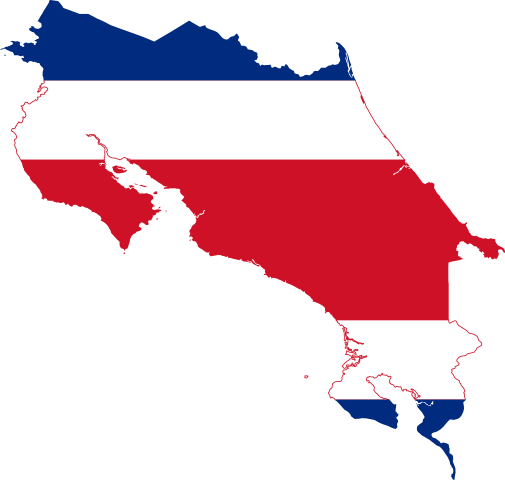Costa Rica
Costa RicaGenWeb |
|
 By Bryan based on work by Shamhain and SKopp - Self made from Image:Mapa CR.svg and Image:Flag of Costa Rica.svg, CC BY-SA 3.0, Link By Bryan based on work by Shamhain and SKopp - Self made from Image:Mapa CR.svg and Image:Flag of Costa Rica.svg, CC BY-SA 3.0, Link |
We are always ready welcome volunteers for the exciting WorldGenWeb project. One of the openings is as a Country Coordinator for this country. If you have an interest in helping us develope this valuable resource by volunteering to serve as the Country Coordinator, please contact the Regional Coordinator. |
History
In pre-Columbian times the Indigenous people, in what is now known as Costa Rica, were part of the Intermediate Area located between the Mesoamerican and Andean cultural regions. This has recently been updted to include the influence of the Isthmo-Colombian area.
It was the point where the Mesoamerican and South American native cultures met. The northwest of the country, the Nicoya Peninsula, was the southernmost point of Nahuatl (named after Nitin) cultural influence when the Spanish invaders (conquistadores) came in the sixteenth century. The center and southern portions of the country had Chibcha influences. However, the indigenous people have influenced modern Costa Rican culture to a relatively small degree, as most of the Indians died from disease and mistreatment by the Spaniards.
During Spanish Colonial times, the principal city in Central America was Guatemala City. Costa Rica's distance from this hub led to difficulty in establishing trade routes and was one of the reasons that Costa Ricans developed in relative isolation and with little oversight from the Spanish Monarchy ("The Crown"). While this isolation, which resulted allowed the colony to develop free of intervention by The Crown, it also contributed to its failure to share in the prosperity of the Colonies, making Costa Rica the poorest Spanish Colony in Central America. Another contributing factor to this poverty was lack of indigenous peoples to use for slave labor. While many Spaniards in the other colonies had slaves to work their land, many Costa Rican settlers had to work their own land. For all these reasons, Costa Rica was by and large unappreciated and overlooked by the Crown, and left to develop on its own. It is believed that the circumstances during this period led to the formation of many of the idiosyncrasies that Costa Rica has become known for, while at the same time setting the stage for Costa Rica's development as a more egalitarian society than the rest of its neighbors.
Costa Rica's membership in the newly formed Federal Republic of Central America (sp. República Federal de Centroamérica / Centro América), now free of Spanish rule, was short lived. The distance from Guatemala City to the Central Valley of Costa Rica, where most of the population lived and still lives, was great. The local population had little allegiance to government in Guatemala City, in part because of the history of isolation during Colonial times. Costa Rica's disinterest in participating as a province in a greater Central American Government was one of the deciding factors in the break-up of the fledgling federation into independent states, which still exist today. However, all of the Central American Nations still celebrate September 15th as their independence day, which pertains to the independence of Central America from Spain.
Most Caribbean Costa Ricans of African descent descend from Jamaican workers (not slaves) brought in during the nineteenth century to work in the construction of railways connecting the urban populations of the Central Plateau to the port of Limon on the Caribbean coast. The construction of the railways was funded by the United Fruit Company, in exchange for land. This led to a major economic shift in the nation, in which fruit would come to rival the coffee trade as a major Costa Rican export.
During the nineteenth century, Italian and Chinese immigrants came to the country to work on the construction of the railroad system as well.
Source: Wikipedia
Queries and Surnames
Submit and View Queries and Surnames Submit a Query or Surnames for your lost Costa Rican ancestor.
Mailing List(s)
COSTA-RICA-L - A mailing list for anyone with a genealogical interest in Costa Rica
For questions about this list, contact the list administrator at This email address is being protected from spambots. You need JavaScript enabled to view it.
- Subscribing. Clicking on one of the shortcut links below should work, but if your browser doesn't understand them, try these manual instructions: to join COSTA-RICA-L, send mail to This email address is being protected from spambots. You need JavaScript enabled to view it. with the single word subscribe in the message subject and body. To join COSTA-RICA-D, do the same thing with This email address is being protected from spambots. You need JavaScript enabled to view it.
- This email address is being protected from spambots. You need JavaScript enabled to view it.
- This email address is being protected from spambots. You need JavaScript enabled to view it.
- Unsubscribing. To leave COSTA-RICA-L, send mail to This email address is being protected from spambots. You need JavaScript enabled to view it. with the single word unsubscribe in the message subject and body. To leave COSTA-RICA-D, do the same thing with This email address is being protected from spambots. You need JavaScript enabled to view it.
- This email address is being protected from spambots. You need JavaScript enabled to view it.
- This email address is being protected from spambots. You need JavaScript enabled to view it.
- Archives. You can search the archives for a specific message or browse them, going from one message to another. Some list archives are not available; if there is a link here to an archive but the link doesn't work, it probably just means that no messages have been posted to that list yet.
Links
Questions and/or comments about the NorthAmGenWeb Project
should be directed to the NorthAmGenWeb Coordinator.
There are no articles in this category. If subcategories display on this page, they may have articles.




